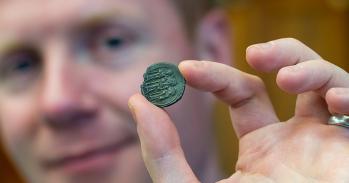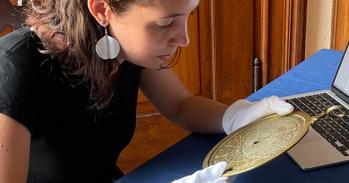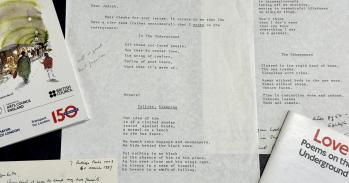
Máire Ní Mhaonaigh is unravelling legends within gems of literature surviving from medieval Ireland.
Máire Ní Mhaonaigh is unravelling legends within gems of literature surviving from medieval Ireland.
The reproduction of texts provided ample opportunity for enterprising scribes – the spin doctors of their own time.
Nestling in the westernmost corner of Western Europe (‘next stop America’), Ireland is often seen as part of a Celtic fringe. Yet, in medieval times, it formed a major intellectual hub, and the wealth of documents that have survived from the period in vellum manuscripts cast light not just on Ireland’s own sophisticated civilisation but on developments in Europe as well.
Unlike clerical counterparts in other places, Irish monks wrote in Latin but also composed copiously in their own language from the 6th and 7th centuries AD onwards, making Old Irish the first vernacular to have achieved literary status. Among their various works are secular narratives dealing with themes as diverse as kingship and kinship, heroism and love. These serve as the most insightful of social commentary, illuminating how society functioned and depicting people’s most pressing concerns.
Medieval spin doctors
Literature is not history, of course, and unravelling the layers of complex texts is often a forensic affair. With recent funding from the Alexander von Humboldt Foundation, Dr Máire Ní Mhaonaigh’s research is concerned with disentangling earlier texts copied over centuries and surviving in manuscripts of the 12th century and later. The reproduction of texts provided ample opportunity for enterprising scribes – the spin doctors of their own time – to put their own subjective slant on events, producing skilful propaganda glorifying their own masters and putting their own issues centre stage. Discerning these biases enables us to evaluate their writing and use it to understand the machinations of life in the authors’ own day.
Mythologising history
In the case of stories concerning real figures, historical sources can provide a measuring stick to determine the degree of mythologisation that has taken place. One particularly powerful ruler, Brian Boru, who died at a ripe old age in battle in 1014, emerges as a wily politician and skilful military campaigner from a reading of contemporary chronicles. Literary works in Irish and in Norse tell a different, much augmented tale, depicting him as conqueror of irrepressible Vikings, a veritable saviour of his own people. It was in his descendants’ interest to peddle this positive image; having a glorious ancestor meant that they too might be deemed great. In the 12th century, Brian’s great-grandson, Muirchertach, who proudly bore his forefather’s name Ua Briain (‘descendant of Brian’) as a surname, commissioned a literary biography of his family hero. Cogadh Gáedhel re Gallaibh (The Viking–Irish War) served as a reminder to potential opponents of what Uí Briain (O’Briens) were made.
Church and ‘State’
Muirchertach was a powerful patron of church reform and his clerical companions bolstered his political ambition by producing useful documents like Cogadh in return. Such constructive cooperation had for centuries ensured that various facets of the life of Ireland’s ruling elite were recorded either as ‘facts’ or in literary form, providing an unrivalled picture of the upper echelons of a society which constituted part of the European norm.
This fruitful fusion was not to continue, and the large 12th-century codex, the Book of Leinster, in which the Cogadh is preserved, may have been one of the last such compilations to have been produced in an ecclesiastical embrace. Nonetheless, the 600 years or more of intense intellectual involvement between clerics and royalty in Ireland offers an unparalleled glimpse of this remarkable time.
For more information, please contact the author Dr Máire Ní Mhaonaigh (mnm21@cam.ac.uk) at the Department of Anglo-Saxon, Norse and Celtic. Dr Ní Mhaonaigh’s book Brian Boru: Ireland’s Greatest King? was published by Tempus in 2007.
This work is licensed under a Creative Commons Licence. If you use this content on your site please link back to this page.





